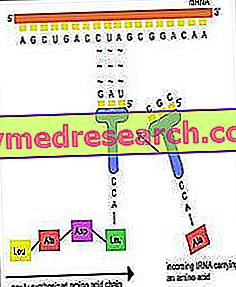For there to be a correspondence between the information of the polynucleotide and that of the polypeptide, there is a code: the genetic code.
The general characteristics of the genetic code can be listed as follows:
The genetic code is composed of triplets, and is devoid of internal punctuation (Crick & Brenner, ).
It has been deciphered through the use of "open cell translation systems" (Nirenberg & Matthaei, 1961; Nirenberg & Leder, 1964; Korana, 1964).
It is highly degenerate (synonyms).
The organization of the code table is not random.
Triplets "nonsense".
The genetic code is "standard", but not "universal".
Observing the table of the genetic code it must be remembered that it refers to the translation of the RNAm to polypeptide, so the nucleotide bases involved are A, U, G, C. The Biosynthesis of a polypeptide chain is the translation of the nucleotide sequence in sequence amino acid.

Each triplet of RNAm bases, called the codon, has the first base in the left column, the second in the top row, the third in the right column. Take for example the tryptophan (ie Try) and we see that the corresponding codon will be, in order, UGG. In fact the first base, U, includes the whole row of boxes at the top; in this, G identifies the rightmost box and the fourth line of the box itself, where we find Try written. Similarly, to synthesize the Leucine-Alanine-Arginine-Serína tetrapeptide (Leu-Ala-Arg-Ser symbols) we can find in the code the UUA-AUC-AGA-UCA codons.

At this point, however, it is worth noting that all the amino acids of our tetrapeptide are encoded (unlike tryptophan) by more than one codon. Not by chance in the example just reported we have chosen the codons indicated. We could have encoded the same tripeptide with a different sequence of RNAm, such as CUC-GCC-CGG-UCC.
Initially, the fact that a single amino acid corresponded to more than one triplet was given a meaning of randomness, expressed also in the choice of the term of degeneration of the code, used to define the phenomenon of synonymy. Some data suggest instead that the availability of synonyms referable to different stability of genetic information is not at all random. This seems to be confirmed also by the finding of a different value of the ratio A + T / G + C in the different stages of evolution. For example in prokaryotes, where the need for variability is not satisfied by the rules of mendelism and neomendelism, the ratio A + T / G + C tends to grow. The consequent lower stability, in the face of mutations, provides greater opportunities for random variability by gene mutation.
In eukaryotes, in particular in the multicellular cells, where it is necessary for the cells of the single organism to preserve all the same hereditary heritage, the ratio A + T / G + C in the DNA tends to decrease, decreasing the occasion of somatic gene mutations.
The existence of synonymous codons in the genetic code raises the problem, already mentioned, of the multiplicity or not of the anticodons in the RNAt.
It is certain that there is at least one RNAt for each amino acid, but it is not as certain whether a single RNAt can bind to a single codon, or it can indifferently recognize synonyms (especially when these differ only for the third base).
We can conclude that there are on average three synonyms codon for each amino acid, while the anticodons are at least one, and not more than three.
Recalling that genes are intended as single traits of very long polynucleotide DNA sequences, it is clear that the beginning and end of the single gene must necessarily be contained in the memory.
BIOSYNTHESIS OF PROTEINS
In different stretches of DNA there is the opening of the double chain and the synthesis of the different types of RNA.
During the loading phase, the RNAt bind to amino acids (previously activated by ATP and specific enzyme). The biosynthetic "machinery" is not able to "correct" tRNAs loaded in the wrong way.
RNAr then splits into the two subunits and, by binding to ribosomal proteins, results in the assembly of ribosomes.
RNAm, passing into the cytoplasm, binds to ribosomes, forming the polysome. Each ribosome, flowing on the messenger, gradually hosts the RNAt complementary to the corresponding codons, taking the amino acids and binding them to the polypeptide chain in formation.
The relatively stable RNAt fall into a circle. Also the ribosomes are used again, freeing the already assembled polypeptide.
The messenger, less stable because it is all monocatenary, is split (from ribonuclease) into constituent ribonucleotides.
The cycle thus continues, synthesizing one after the other the polypeptides on the messenger RNAs provided by the transcription.
Edited by: Lorenzo Boscariol



